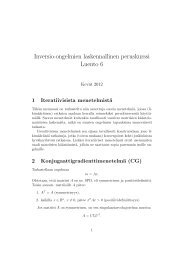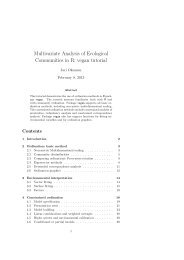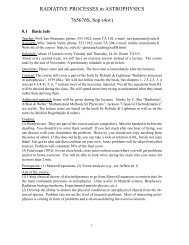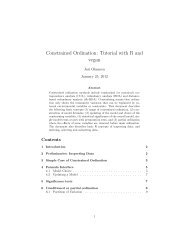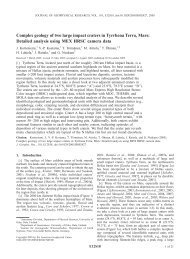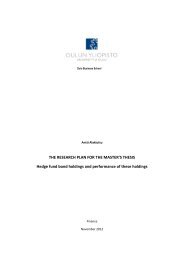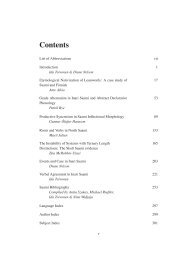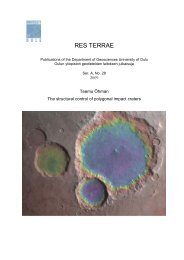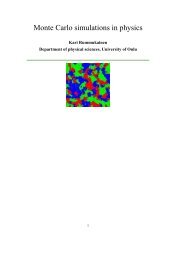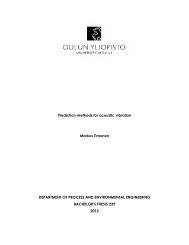Juha Köykkä - Oulu
Juha Köykkä - Oulu
Juha Köykkä - Oulu
- TAGS
- juha
- oulu
- cc.oulu.fi
Create successful ePaper yourself
Turn your PDF publications into a flip-book with our unique Google optimized e-Paper software.
Res Terrae, Ser. A 32, J. <strong>Köykkä</strong>, Sedimentology of the Mesoproterozoic Telemark basin-fills, South Norway: implications for<br />
sedimentation processes, depositional environments and tectonic evolution<br />
basin evolution should emerge. Thus, a multifaceted approach is necessary to under-<br />
stand a sedimentary basin as a dynamic system. Paper IV provides evidence for the<br />
origin of the Rjukan Rift Basin by combining the detrital zircon age patterns with the<br />
sedimentary lithofacies to create a paleotectonic reconstruction and depositional model<br />
and to determine the source areas. The rift-filling model presented in Paper IV allows<br />
correlations to be made with other similar supracrustal rocks in southern Norway.<br />
The provenance of the sampled sediments was evaluated from in situ U-Pb and Lu-<br />
Hf analysis of detrital zircon grains by LA-ICP-MS. Six samples was selected. They<br />
are distributed in all formations of the Vindeggen Group made of coarse clastic sedi-<br />
ment, i.e. containing coarse zircon grains suitable for analysis. They represent, from<br />
bottom to top, the Heddersvatnet, Gausta, Skottsfjell, Vindsjå, and Brattefjell forma-<br />
tions (from two different members). The sedimentary rocks and U-Pb age patterns of<br />
the Rjukan Rift Basin can be explained by a continental rift basin tectonic model. This<br />
model shows the development from syn-rift to post-rift stages, and it includes marine<br />
incursions. The subsidence and sedimentation rates were more intensive at the syn-rift<br />
stage, and this stage involved coarse clastic alluvial sedimentation with a distinct local<br />
provenance. In the detrital zircon record, grains older than ca. 1500 Ma are evidence of<br />
a pre-rifting basement source. These grains were probably brought into the basin by an<br />
axial river or along the rift margin ramps. During the post-rift stage, the basin was<br />
completely filled, and an epicontinental sea covered southern Norway. The trend of a<br />
diminishing local signal is seen in the detrital zircon pattern throughout the rift infill.<br />
Paleoproterozoic rocks were important sources in the basin’s history, and matching<br />
rocks can be found in the southern Fennoscandia and northeastern Laurentia. Thus,<br />
Paper IV suggested that the Rjukan Rift Basin was situated closer to the Laurentia and<br />
later moved to its present location along a sinistral strike-slip fault. Based on the Hf<br />
isotope data and striking overlapping ages, the zircon grains came from the same<br />
source during the entire rift infilling history. Other Mesoproterozoic quartzites in south<br />
Norway were probably deposited after the Rjukan Rift Basin was completely filled and<br />
the sediments “spilled over” the rift margins. A correlation with these sediments is<br />
supported by a similar U-Pb age pattern and shallow marine sedimentological charac-<br />
teristics.<br />
56



